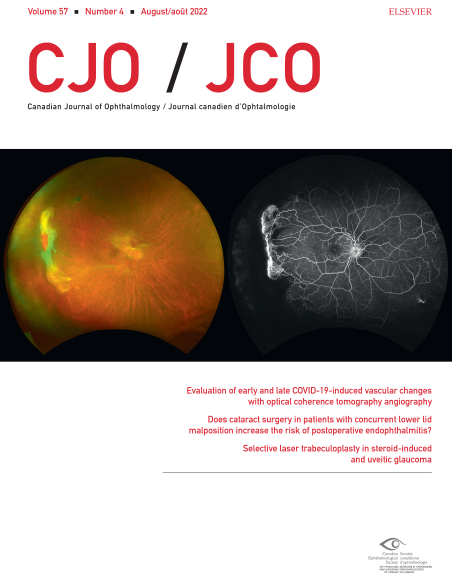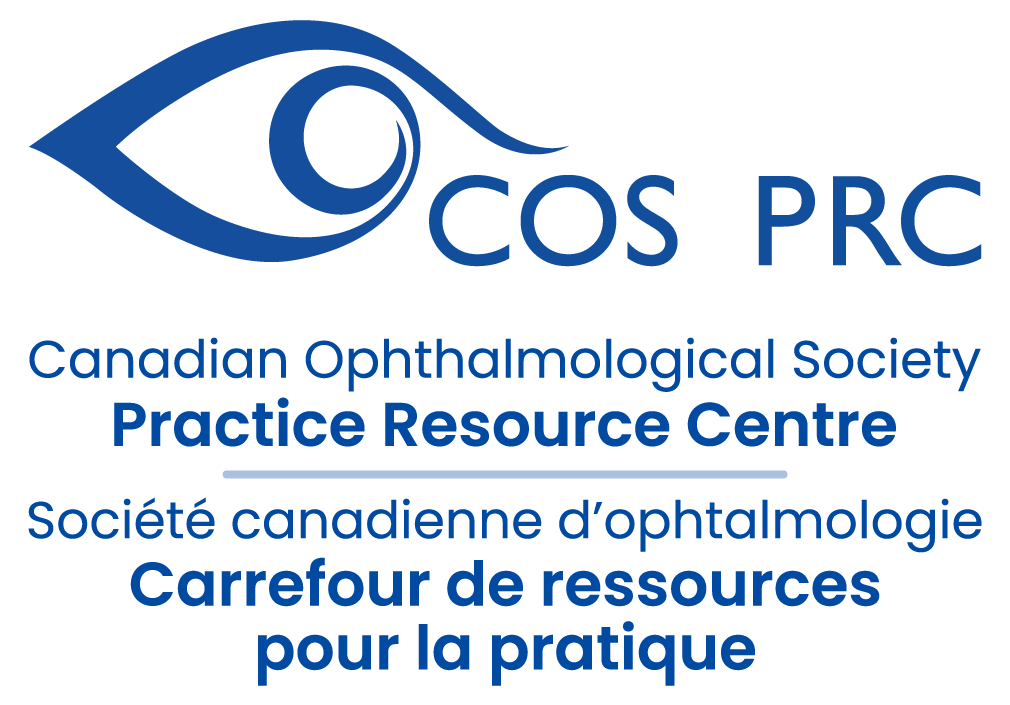CJO August 2022 Highlights

The August 2022 CJO is now available online. Here are some of the highlights:
Resident Perspectives + visual abstract: Our amazing team of residents have summarized 7 articles with a focus on what’s most relevant to ophthalmology learners here in Canada and around the globe, including the article featured in our August visual abstract, Pretreatment with frequent topical betamethasone in Ahmed glaucoma valve implantation.
Review article: Advances in magnetic resonance imaging of orbital disease
Original research articles:
· Clinical audit of retinoblastoma management: a retrospective single-institution study
· Longitudinal assessment of type 3 macular neovascularization using 3D volume-rendering OCTA
· Chalazion: racial risk factors for formation, recurrence, and surgical intervention
· Challenging the current treatment of residual postoperative ptosis: safety and efficacy of repeat Müller’s muscle conjunctival resection
Research letters, photo essays, and case reports:
· Bilateral curvilinear chorioretinal streaks [photo essay]
· Gore-Tex suture exposure following transscleral fixation of an intraocular lens [photo essay]
· Transplantation of autologous lamellar scleral graft for the treatment of corneal perforation [case report]
· Experiences from a national webinar with recently matched Canadian ophthalmology residents for medical students [case report]
· Uveal melanoma presenting as panophthalmitis in the absence of an intraocular mass [correspondence]
Follow the CJO on social media:
Twitter: @CanJOphth
Instagram: @cjo_jco
Facebook: CanJOphth
Canadian Ophthalmology Curriculum Topics, Objectives & Resources
Canadian Ophthalmology Curriculum Topics & Objectives
This document is the finalized list of curriculum topics and objectives for Canadian undergraduate medical education in ophthalmology. The development of this list was based off three resources: The 2018 objective list developed by the Association of University Professors in Ophthalmology (AUPO) with endorsement from the American Academy of Ophthalmology (AAO)1, the AUPO’s 2009 Ophthalmology Core Knowledge and Skills competencies2,and the Medical Council of Canada’s (MCC) objectives pertaining to ophthalmology3.
After a preliminary list of objectives was made based off the previously mentioned resources, a survey was sent to the members of AUPO asking for expert opinion on each curriculum objective and if they warrant inclusion. Based on this survey, talking points were created and later discussed in a virtual meeting where the list was finalized.
*Urgent and red flag conditions have been denoted with a red Asterix. These warrant urgent referral to an ophthalmologist.
Download the full PDF Document here:

Click on the links below to explore the topics:
ICO Connections – The ICO Celebrates Landmark WHO Eye Care Guide

The Eye Care in Health Systems: Guide for Action provides practical, step-by-step, guidance to support Member States in planning and implementing the recommendations of the World report on vision with the goal to provide integrated people-centered eye care services.
This new resource leads Member States through a four-step process: situation analysis; development of an eye care strategic plan and monitoring framework; development and implementation of an operational plan; and establishing and maintaining ongoing review processes.
Currently, more than 2 billion people are living with a vision impairment and of these, at least 1 billion people are needlessly living with poor vision due to lack of access to eye care services. This burden is not borne equally: 90 percent of people with vision impairment or blindness live in low- and middle-income countries. Often, all that is needed is a cost-effective intervention, such as a pair of spectacles or cataract surgery.
Implementing integrated people-centred eye care has the potential to improve millions of lives worldwide and produce huge benefits for the economy, gender equity, inclusion, education and the workplace.
The Guide links to other tools developed by WHO, through consultations with international experts, including:
The Guide currently links four resources, or tools, including:
- Eye care situation analysis tool (ECSAT)
Purpose: Questionnaire based survey tool to comprehensively assess eye care in a country. - Eye care indicator menu (ECIM)
Purpose: List of recommended eye care indicators to be collected regularly. - Package of eye care interventions (PECI)
Purpose: Planning and budgeting for eye care at each level of the health system. - Eye care competency framework (ECCF)
Purpose: Planning tool for eye care human resources based on competencies.
For more information click the link below:

Canadian Eyecare Today Issue No. 1
| The first issue of Canadian Eyecare Today for 2022 is now available for your reading pleasure. This publication examines issues and topics that are relevant to today’s clinician in the treatment and management of eye disease from a Canadian perspective. To subscribe to this publication now, please click here. |
| Some of the content you will find in this issue THE EVOLVING ROLE OF OCT IN PATHOLOGIC MYOPIA Carl Shen, MD Mark Seamone, MD Mark Greve, MD METHODS TO TREAT MYOPIA PROGRESSION IN PEDIATRIC PATIENTS Michael J. Wan, MD SPOT THE DIFFERENCES: CHALLENGES IN DETECTING GLAUCOMA IN THE MYOPIC PATIENT Cindy M.L. Hutnik, MD, PhD, FRCSC and Michael T. Kryshtalskyj, MD Kian M. Madjedi, MD, MPhil Andrew C.S. Crichton, MD, FRCSC CATARACT SURGERY IN THE MYOPE: WHAT YOU SHOULD KNOW Joshua Teichman, MD, MPH, FRCSC GLAUCOMA AND MYOPIA: RISK FACTORS, PATHOPHYSIOLOGY, AND TREATMENT Jing Wang, MD Please feel free to forward the publication link to your peers! |
The ICO shares the recent launch of the World Health Organization’s (WHO) global guidelines to support women and newborns in the postnatal period

Eye Care Embedded in New WHO Neonatal Care Guidelines
The ICO shares the recent launch of the World Health Organization’s (WHO) global guidelines to support women and newborns in the postnatal period.
For the first time ever, eye care has been embedded in neonatal care guidelines, demonstrating the importance of access to high-quality vision care in the healthy development of babies.
The ICO is in Official Relation status with the WHO. We encourage all ICO Member Societies to share these new guidelines with their networks.
CJO April 2022 Issue Highlights
The April 2022 CJO is now available online. Here are some of the highlights:
Resident Perspectives + visual abstract: Our amazing team of residents have summarized 7 articles with a focus on what’s most relevant to ophthalmology learners here in Canada and around the globe, including the article featured in our April visual abstract, Frozen versus fresh corneal graft carriers in Boston keratoprosthesis surgery: 10-year outcomes.
Original research articles:
- SD-OCT assessment of macular and optic nerve alterations in patients recovered from COVID-19
- Sunlamp use is a risk factor for uveal melanoma: a meta-analysis
- Ocular manifestations of disseminated Mycobacterium chimaera infection after cardiothoracic surgery
- Evaluation of dry eye disease in children with blepharokeratoconjunctivitis
- Reversible HER2 antibody-drug conjugate–induced ocular toxicity
Research letters and case reports:
- Features and management of strabismus from skull base chordoma [research letter]
- Clinical course and poor prognostic factors of Vogt–Koyanagi–Harada disease in a tertiary uveitis clinic [research letter]
- Making the most of what you have: improving patient and provider experiences at an eye clinic through interior design [case report]
- Building better education after COVID-19: the 2021 Canadian ophthalmology residency match [case report]
- Detection of Alcaligenes chronic endophthalmitis mimicking noninfectious uveitis with 16S ribosomal RNA PCR [case report]
Follow the CJO on social media:
Twitter: @CanJOphth
Instagram: @cjo_jco
Facebook: CanJOphth
Re-Visioning: Stargardt Disease
An article, entitled Re-visioning by Carol Yaple, which was included in the CMAJ, Vol. 194, Issue 97 Mar 2022
« On Dec. 1, 2011, I received a diagnosis of Stargardt disease, an inherited retinal disorder that affects central vision. Genetic testing showed that my mother carried the mutation, and my father contributed a common variant. One in 10 000 are afflicted with this rare condition, which often presents in childhood. »
Read the Full Article here:
How to Claim Section 3 Credits for Quality Improvement Activities?
How do quality improvement activities relate to CPD offerings?
| A Fellow receives information about practice guidelines or an area of practice for any of the CanMEDS Roles/practice settings | The Fellow could identify an area of their practice to evaluate and follow these guidelines to assess, identify, and measure areas for quality improvement using Practice Assessment guidelines for MOC Section 3 credits |
| The Fellow could review their charts/ electronic health records to assess performance against these clinical measure(s) to identify areas for quality improvement using Chart Audit guidelines for MOC Section 3 credits |
Guide essentiel sur l’amélioration de la qualité
Élargir l’apprentissage la mise en œuvre de l’AQ
S’alignant sur les appels à l’intégration de l’amélioration de la qualité et de l’apprentissage continu des médecins le Collège royal actualise son programme de MDC. Reposant sur de brèves étapes pratiques, cette stratégie renouvelée du programme de MDC vise à rendre le programme plus pertinent, davantage axé sur l’amélioration et plus convivial, permettant ainsi aux médecins d’obtenir des résultats importants pour eux et leurs patients dans les soins qui leur sont prodigués.
Bien que ces objectifs collectifs soient clairs, il se peut que certains spécialistes ne connaissent pas bien les principes de l’AQet éprouvent de la difficulté à les rattacher à l’important travail d’amélioration qu’ils accomplissent déjà. D’autres ont peut-être du mal à déterminer comment mettre en œuvre l’AQ dans un rôle de pratique donné (p. ex., clinicien, éducateur, administrateur) ou dans le cadre d’une transition de carrière.
L’orientation qui suit fournit :
- une introduction à la science de l’amélioration de la qualité;
- des outils, des ressources et des exemples illustratifs pour aider à établir des liens entre l’AQ et la pratique professionnelle existante;
- de l’aide pour planifier, mettre en œuvre et rendre compte de nouvelles initiatives d’AQ dans la pratique professionnelle actuelle;
- de l’orientation sur la consignation des activités d’AQ dans la section 3 (Évaluation) du programme de MDC (3 crédits par heure).
Pour des informations sur la mise en œuvre de l’AQ, visitez le site web du Royal College.




